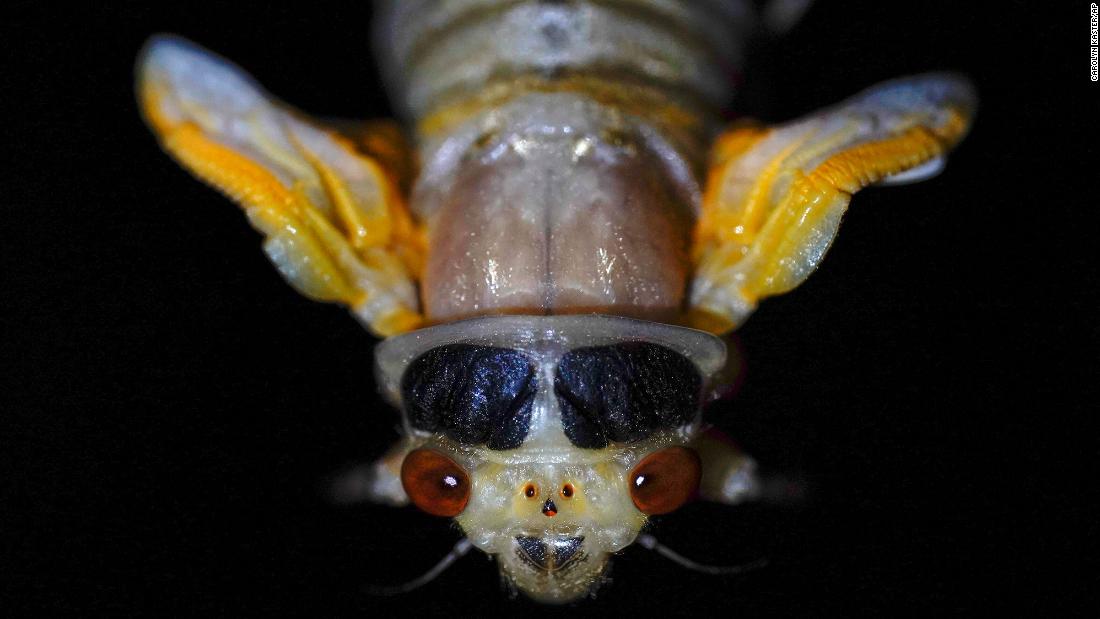A Brood X cicada hangs upside down after shedding its nymph shell.
The Brood X cicadas are here — and many more are on the way.
The insects have spent the last 17 years underground, and they’re now starting to emerge across parts of the eastern United States.
For many people, just the thought of these bugs grosses them out and fills them with dread.
Carolyn Kaster is not one of those people. The Associated Press photographer, based in Washington, DC, has been getting as close as she can to these cicadas as they start to come out in her area.
For weeks, Kaster has been photographing these periodical cicadas, which come out every 17 years — and only in this part of the world.
“They’re just so beautifully weird and really fun to photograph,” she said.
Kaster spent many of her nights crawling around on the ground, trying to get the best shots.
“Every time I went out, I found something really special,” she said. “I was surprised every time.”


An adult cicada crawls up Kaster’s leg.

A cicada that hasn’t completely shed its shell spreads its wings on a the base of a tree.
Billions of these bugs will be emerging over the coming weeks. They start as nymphs, crawling up from the ground and shedding their exoskeletons on plants, trees and other vertical surfaces.
“They will crawl up anything, including photographers,” Kaster said. “So I literally had them in my hair, in my ears, up my sleeves, in my shoes. Every once in a while, I reached my limit and had to stand up and shake them off.”
After the nymphs shed their exoskeletons and their adult bodies form, they will fly away and spend their brief lifespans — about four to six weeks — looking for a mate. The loud buzzing of the male’s mating song will be annoyingly loud to some, but awe-inspiring for others.
“It’s really cool. You just don’t see this very often in your life,” Kaster said. “What a crazy life cycle these bugs have.”


Kaster remembers being fascinated by the cicadas in 2004, the last time they emerged, and she’s been looking forward to 2021 because of it.
“I’ve been thinking about it for a long time. When I heard they were coming back and that it was drawing near, I looked into some of the fancy macro lenses to really dive into this,” she said.
Kaster’s lenses allow her to photograph these insects in amazing detail, right in their habitat.
“The greens just kind of fall back and saturate, and the contrast, with their little red beady eyes, it’s just awesome,” she said.

A red-eyed adult cicada hangs on a tree next to a cicada shedding its nymph shell.

Adult cicadas and shedding nymphs cling to a flowering plant.

The silhouette of an adult cicada.

While a street light shines in the distance, a cicada hangs upside down after shedding its shell.
To shoot at night and get the light that she needs, Kaster will rig a bunch of little flashlights on tripods. She also spreads portable work lights on the ground, and sometimes she’ll hold her camera with one hand while holding a penlight in her other hand.
One of her macro lenses — about a foot and a half long and as narrow as a cigar — comes with a little ring light at the end of it.
“You can see (the light) reflected in their little bug eyes,” she said.


Many of the cicadas in these photos were in College Park, Maryland, as Kaster teamed up with a group of entomologists and their students who were tracking the insects at the University of Maryland.
Kaster and the team would put thermometers into the ground and wait for the soil temperature to reach 64 degrees Fahrenheit — the temperature when cicadas start to emerge. Kaster would often get a text from someone across campus when nymphs were spotted, and she’d rush to the scene.
“Finding them early was such an adventure,” Kaster said.


A cicada nymph sticks out of mulch and soil.

A cicada sheds its nymph shell.
The cicadas aren’t harmful to humans or animals. They don’t bite. They just crawl — everywhere.
“You’re picking them up, you’re taking them off your lenses. I had them crawling all over my cameras. I had them crawling all over me. It’s bananas,” Kaster said.
This is just the “front edge” of the emergence, she said, and she’s excited to keep taking photos of them. Even if they might be getting a little too close for comfort.
“They would come home with me, because they’d be on my clothes,” she said. “The other day, I saw a shell. I think they’re in my house!”





